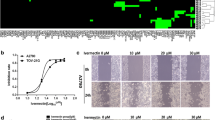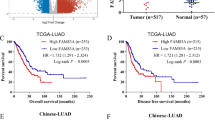Abstract
Epstein-Barr virus (EBV) has been widely recognized to contribute to the development of nasopharyngeal carcinoma (NPC). The present study was to explore the association of plasma Epstein-Barr Virus LMP1 and EBER1 with circulating tumor cells (CTCs) and the metastasis of nasopharyngeal carcinoma. In the present study, we quantified the plasma levels of EBV DNA/RNAs, such as LMP1, LMP2, BART and EBER1 with real-time quantitative PCR, and CTCs with a CellSpotter Analyzer in NPC patients, with or without metastasis. Then the correlation of each biomarker with other biomarkers and tumor metastasis was analyzed. Our data indicated that the plasma levels of EBV LMP1, BART, EBER1, along with CTCs were significantly higher in metastatic NPC patients than in non-metastatic patients. Plasma LMP1 DNA and EBER1 discriminate metastatic NPC patients from non-metastatic patients, correlate with tumor stage and node stage for metastatic NPC patients. In summary, there were significantly higher plasma levels of Epstein-Barr Virus DNAs / RNAs in nasopharyngeal carcinoma patients. LMP1 DNA and EBER1 RNA correlated with the metastasis of nasopharyngeal carcinoma.





Similar content being viewed by others
References
Torre LA, Bray F, Siegel RL, Ferlay J, Lortet-Tieulent J, Jemal A (2015) Global cancer statistics, 2012. CA Cancer J Clin 65:87–108. https://doi.org/10.3322/caac.21262
Chua M, Wee J, Hui EP, Chan A (2016) Nasopharyngeal carcinoma. Lancet 387:1012–1024. https://doi.org/10.1016/S0140-6736(15)00055-0
Smatti MK, Al-Sadeq DW, Ali NH, Pintus G, Abou-Saleh H, Nasrallah GK (2018) Epstein-Barr virus epidemiology, serology, and genetic variability of LMP-1 Oncogene among healthy population: an update. Front Oncol 8:211. https://doi.org/10.3389/fonc.2018.00211
Pathmanathan R, Prasad U, Sadler R, Flynn K, Raab-Traub N (1995) Clonal proliferations of cells infected with Epstein-Barr virus in preinvasive lesions related to nasopharyngeal carcinoma. N Engl J Med 333:693–698. https://doi.org/10.1056/NEJM199509143331103
Liebowitz D (1994) Nasopharyngeal carcinoma: the Epstein-Barr virus association. Semin Oncol 21:376–381
Tsao SW, Tsang CM, To KF, Lo KW (2015) The role of Epstein-Barr virus in epithelial malignancies. J Pathol 235:323–333. https://doi.org/10.1002/path.4448
Zou X, You R, Liu H et al (2017) Establishment and validation of M1 stage subdivisions for de novo metastatic nasopharyngeal carcinoma to better predict prognosis and guide treatment. Eur J Cancer 77:117–126. https://doi.org/10.1016/j.ejca.2017.02.029
Taylor GS, Blackbourn DJ (2011) Infectious agents in human cancers: lessons in immunity and immunomodulation from gammaherpesviruses EBV and KSHV. Cancer Lett 305:263–278. https://doi.org/10.1016/j.canlet.2010.08.019
Young LS, Arrand JR, Murray PG (2007) EBV gene expression and regulation. In: Arvin A, Campadelli-Fiume G, Mocarski E, Moore PS, Roizman B, Whitley R, Yamanishi K (eds) Human Herpesviruses: Biology, Therapy, and Immunoprophylaxis, Chapter 27. Cambridge University Press, Cambridge
Lin JC, Wang WY, Chen KY et al (2004) Quantification of plasma Epstein-Barr virus DNA in patients with advanced nasopharyngeal carcinoma. N Engl J Med 350:2461–2470. https://doi.org/10.1056/NEJMoa032260
Chan AT, Lo YM, Zee B et al (2002) Plasma Epstein-Barr virus DNA and residual disease after radiotherapy for undifferentiated nasopharyngeal carcinoma. J Natl Cancer Inst 94:1614–1619
Chan A, Hui EP, Ngan R et al (2018) Analysis of plasma Epstein-Barr virus DNA in nasopharyngeal Cancer after Chemoradiation to identify high-risk patients for adjuvant chemotherapy: a randomized controlled trial. J Clin Oncol: O2018777847. https://doi.org/10.1200/JCO.2018.77.7847
Lin JC, Wang WY, Liang WM et al (2007) Long-term prognostic effects of plasma epstein-barr virus DNA by minor groove binder-probe real-time quantitative PCR on nasopharyngeal carcinoma patients receiving concurrent chemoradiotherapy. Int J Radiat Oncol Biol Phys 68:1342–1348. https://doi.org/10.1016/j.ijrobp.2007.02.012
Pegtel DM, Middeldorp J, Thorley-Lawson DA (2004) Epstein-Barr virus infection in ex vivo tonsil epithelial cell cultures of asymptomatic carriers. J Virol 78:12613–12624. https://doi.org/10.1128/JVI.78.22.12613-12624.2004
Hudnall SD, Ge Y, Wei L, Yang NP, Wang HQ, Chen T (2005) Distribution and phenotype of Epstein-Barr virus-infected cells in human pharyngeal tonsils. Mod Pathol 18:519–527. https://doi.org/10.1038/modpathol.3800369
Shannon-Lowe C, Adland E, Bell AI, Delecluse HJ, Rickinson AB, Rowe M (2009) Features distinguishing Epstein-Barr virus infections of epithelial cells and B cells: viral genome expression, genome maintenance, and genome amplification. J Virol 83:7749–7760. https://doi.org/10.1128/JVI.00108-09
Tao Q, Swinnen LJ, Yang J, Srivastava G, Robertson KD, Ambinder RF (1999) Methylation status of the Epstein-Barr virus major latent promoter C in iatrogenic B cell lymphoproliferative disease. Application of PCR-based analysis. Am J Pathol 155:619–625. https://doi.org/10.1016/S0002-9440(10)65157-7
Tong JH, Tsang RK, Lo KW et al (2002) Quantitative Epstein-Barr virus DNA analysis and detection of gene promoter hypermethylation in nasopharyngeal (NP) brushing samples from patients with NP carcinoma. Clin Cancer Res 8:2612–2619
Cosmopoulos K, Pegtel M, Hawkins J et al (2009) Comprehensive profiling of Epstein-Barr virus microRNAs in nasopharyngeal carcinoma. J Virol 83:2357–2367. https://doi.org/10.1128/JVI.02104-08
Brooks L, Yao QY, Rickinson AB, Young LS (1992) Epstein-Barr virus latent gene transcription in nasopharyngeal carcinoma cells: coexpression of EBNA1, LMP1, and LMP2 transcripts. J Virol 66:2689–2697
Prayongrat A, Chakkabat C, Kannarunimit D, Hansasuta P, Lertbutsayanukul C (2017) Prevalence and significance of plasma Epstein-Barr virus DNA level in nasopharyngeal carcinoma. J Radiat Res 58:509–516. https://doi.org/10.1093/jrr/rrw128
Lertbutsayanukul C, Kannarunimit D, Prayongrat A, Chakkabat C, Kitpanit S, Hansasuta P (2018) Prognostic value of plasma EBV DNA for nasopharyngeal Cancer patients during treatment with intensity-modulated radiation therapy and concurrent chemotherapy. Radiol Oncol 52:195–203. https://doi.org/10.2478/raon-2018-0016
Kaye KM, Izumi KM, Mosialos G, Kieff E (1995) The Epstein-Barr virus LMP1 cytoplasmic carboxy terminus is essential for B-lymphocyte transformation; fibroblast cocultivation complements a critical function within the terminal 155 residues. J Virol 69:675–683
Huen DS, Henderson SA, Croom-Carter D, Rowe M (1995) The Epstein-Barr virus latent membrane protein-1 (LMP1) mediates activation of NF-kappa B and cell surface phenotype via two effector regions in its carboxy-terminal cytoplasmic domain. Oncogene 10:549–560
Turunen A, Rautava J, Grenman R, Syrjanen K, Syrjanen S (2017) Epstein-Barr virus (EBV)-encoded small RNAs (EBERs) associated with poor prognosis of head and neck carcinomas. Oncotarget 8:27328–27338. https://doi.org/10.18632/oncotarget.16033
Chang Y, Cheng SD, Tsai CH (2002) Chromosomal integration of Epstein-Barr virus genomes in nasopharyngeal carcinoma cells. Head Neck 24:143–150
Kaschka-Dierich C, Adams A, Lindahl T et al (1976) Intracellular forms of Epstein-Barr virus DNA in human tumour cells in vivo. Nature 260:302–306
Pantel K, Brakenhoff RH, Brandt B (2008) Detection, clinical relevance and specific biological properties of disseminating tumour cells. Nat Rev Cancer 8:329–340. https://doi.org/10.1038/nrc2375
Lianidou ES, Markou A (2011) Circulating tumor cells in breast cancer: detection systems, molecular characterization, and future challenges. Clin Chem 57:1242–1255. https://doi.org/10.1373/clinchem.2011.165068
Stevens SJ, Brink AA, Middeldorp JM (2005) Profiling of Epstein-Barr virus latent RNA expression in clinical specimens by gene-specific multiprimed cDNA synthesis and PCR. Methods Mol Biol 292:27–38
Pavlovitch JH, Didierjean L, Rizk M, Balsan S, Saurat JH (1983) Skin calcium-binding protein: distribution in other tissues. Am J Phys 244:C50–C57. https://doi.org/10.1152/ajpcell.1983.244.1.C50
Ramayanti O, Juwana H, Verkuijlen SA et al (2017) Epstein-Barr virus mRNA profiles and viral DNA methylation status in nasopharyngeal brushings from nasopharyngeal carcinoma patients reflect tumor origin. Int J Cancer 140:149–162. https://doi.org/10.1002/ijc.30418
Xu YJ, Zhou R, Zong JF et al (2019) Epstein-Barr virus-coded miR-BART13 promotes nasopharyngeal carcinoma cell growth and metastasis via targeting of the NKIRAS2/NF-kappaB pathway. Cancer Lett 447:33–40. https://doi.org/10.1016/j.canlet.2019.01.022
Zuo LL, Zhang J, Liu LZ et al (2017) Cadherin 6 is activated by Epstein-Barr virus LMP1 to mediate EMT and metastasis as an interplay node of multiple pathways in nasopharyngeal carcinoma. Oncogenesis 6:402. https://doi.org/10.1038/s41389-017-0005-7
Huang D, Song SJ, Wu ZZ et al (2017) Epstein-Barr virus-induced VEGF and GM-CSF drive nasopharyngeal carcinoma metastasis via recruitment and activation of macrophages. Cancer Res 77:3591–3604. https://doi.org/10.1158/0008-5472.CAN-16-2706
**e XQ, Luo Y, Ma XL et al (2019) Clinical significance of circulating tumor cells and their expression of cyclooxygenase-2 in patients with nasopharyngeal carcinoma. Eur Rev Med Pharmacol Sci 23:6951–6961. https://doi.org/10.26355/eurrev_201908_18735
Lee SW, Chen YW, Kuan EC, Lan MY (2019) Dual-function nanostructured platform for isolation of nasopharyngeal carcinoma circulating tumor cells and EBV DNA detection. Biosens Bioelectron 142:111509. https://doi.org/10.1016/j.bios.2019.111509
You R, Liu YP, Lin M et al (2019) Relationship of circulating tumor cells and Epstein-Barr virus DNA to progression-free survival and overall survival in metastatic nasopharyngeal carcinoma patients. Int J Cancer 145:2873–2883. https://doi.org/10.1002/ijc.32380
Acknowledgements
This study was performed in First Hospital of Jilin University, Changchun, China.
Funding
The present study was supported by the grant from Jilin Province Science and Technology Development Plan (20160101051JC).
Author information
Authors and Affiliations
Corresponding authors
Ethics declarations
Conflict of Interests
The Authors declare that they have no conflict of interests.
Additional information
Publisher’s Note
Springer Nature remains neutral with regard to jurisdictional claims in published maps and institutional affiliations.
Rights and permissions
About this article
Cite this article
Sun, L., Wang, Y., Shi, J. et al. Association of Plasma Epstein-Barr Virus LMP1 and EBER1 with Circulating Tumor Cells and the Metastasis of Nasopharyngeal Carcinoma. Pathol. Oncol. Res. 26, 1893–1901 (2020). https://doi.org/10.1007/s12253-019-00777-z
Received:
Accepted:
Published:
Issue Date:
DOI: https://doi.org/10.1007/s12253-019-00777-z




